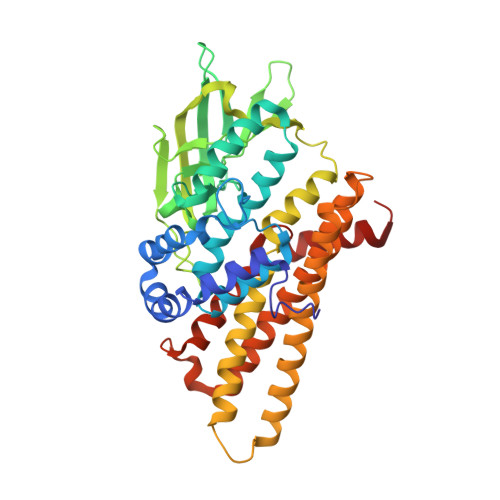Structure and mechanism of ORF36, an amino sugar oxidizing enzyme in everninomicin biosynthesis .
Vey, J.L., Al-Mestarihi, A., Hu, Y., Funk, M.A., Bachmann, B.O., Iverson, T.M.(2010) Biochemistry 49: 9306-9317
- PubMed: 20866105
- DOI: https://doi.org/10.1021/bi101336u
- Primary Citation of Related Structures:
3MXL - PubMed Abstract:
Everninomicin is a highly modified octasaccharide that belongs to the orthosomycin family of antibiotics and possesses potent Gram-positive antibiotic activity, including broad-spectrum efficacy against multidrug resistant enterococci and Staphylococcus aureus. Among its distinctive structural features is a nitro sugar, l-evernitrose, analogues of which decorate a variety of natural products. Recently, we identified a nitrososynthase enzyme encoded by orf36 from Micromonospora carbonacea var. africana that mediates the flavin-dependent double oxidation of synthetically generated thymidine diphosphate (TDP)-l-epi-vancosamine to the corresponding nitroso sugar. Herein, we utilize a five-enzyme in vitro pathway both to verify that ORF36 catalyzes oxidation of biogenic TDP-l-epi-vancosamine and to determine whether ORF36 exhibits catalytic competence for any of its biosynthetic progenitors, which are candidate substrates for nitrososynthases in vivo. Progenitors solely undergo single-oxidation reactions and terminate in the hydroxylamine oxidation state. Performing the in vitro reactions in the presence of (18)O(2) establishes that molecular oxygen, rather than oxygen from water, is incorporated into ORF36-generated intermediates and products and identifies an off-pathway product that correlates with the oxidation product of a progenitor substrate. The 3.15 Å resolution X-ray crystal structure of ORF36 reveals a tetrameric enzyme that shares a fold with acyl-CoA dehydrogenases and class D flavin-containing monooxygenases, including the nitrososynthase KijD3. However, ORF36 and KijD3 have unusually open active sites in comparison to these related enzymes. Taken together, these studies map substrate determinants and allow the proposal of a minimal monooxygenase mechanism for amino sugar oxidation by ORF36.
Organizational Affiliation:
Department of Pharmacology, Vanderbilt University Medical Center, Nashville, TN 37232, USA.














